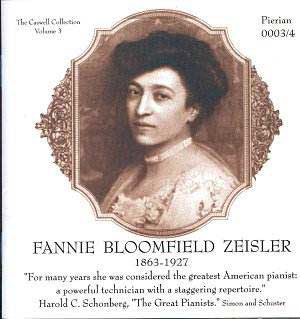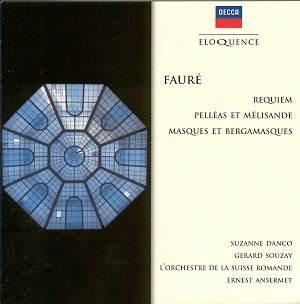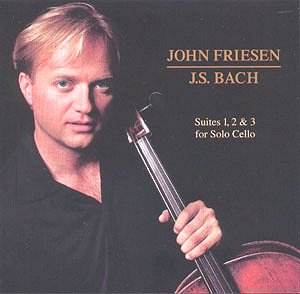 Composer: Fannie Bloomfield Zeisler
Composer: Fannie Bloomfield Zeisler
Works: Frederic Chopin: Scherzo op. 31; Nocturne op. 27 no. 2; Nocturne op. 48; Scherzo op. 20; Waltz op. 70 no. 1; Waltz op. 64 no. 1; Piano Sonata op. 35; Ludwig van Beethoven: Sonata op. 111; Ruins of Athens March (transcribed Anton Rubinstein); Moritz Moskowski: La Jongleuse; Frühling; Domenico Scarlatti: Pastorale (transcribed Tausig); Capriccio (transcribed Tausig); Howard Brockway: Serenade; Anton Rubinstein: Barcarolle op. 30 no. 1; Eduard Schutt: Croquis et Silhouettes op. 87 no. 4; Felix Mendelssohn: Songs without Words op. 62 no. 4; Cecile Chaminade: La Retour op. 134; Johannes Brahms: Rhapsody op. 119 no. 4; Eugen d’Albert: Suite op. 1, Gavotte and Musette; J.S. Bach: Organ Toccata and Fugue (transcribed Tausig)
Performers: Fannie Bloomfield Zeisler, piano
Recording: Reproducing Piano Rolls, recorded 1908-24
Label: Pierian 003-004 [2 CDs 132’16]
Fannie Bloomfield Zeisler, a prominent figure in the early 20th-century classical music scene, emerges as a compelling subject of study in this fascinating double CD release of her reproducing piano rolls. Born in 1863 in Bielitz, Austrian Silesia, and later emigrating to the United States, she was a distinguished pupil of Theodor Leschetizky and became a celebrated performer, known for her interpretative prowess and technical skill. This collection features selections from her recordings made between 1908 and 1924, capturing a pivotal moment in the evolution of piano performance and recording technology.
The performances in this collection are presented with a remarkable fidelity that speaks to the quality of the Welte Mignon system used to produce them. The recordings allow listeners to appreciate the nuances of Bloomfield Zeisler’s playing, particularly in her dynamic range and expressive capabilities. The sound quality, though occasionally marred by tuning issues, is largely impressive, allowing the listener to engage with the subtleties of her interpretations. The dynamic levels of each note reflect her playing style authentically, a significant achievement given the limitations of early recording technology.
Bloomfield Zeisler’s interpretations reveal a vibrant and compelling musical personality, though she occasionally strays into uneven territory. Her performance of Chopin’s Scherzo op. 31 showcases her penchant for swift tempi and energetic articulation, at times bordering on the frenetic. The lively character of this piece, coupled with her crisp phrasing, illustrates her technical command, yet it raises questions about clarity and control in her faster passages. Conversely, her rendition of the Chopin Sonata, while initially prosaic, builds in momentum and intensity, culminating in a strikingly involved interpretation that highlights her emotional engagement with the music.
In the Beethoven Sonata op. 111, her approach is marked by a gradual unfolding of musical ideas, though the initial thematic statements feel somewhat restrained. However, as the performance progresses, she gains in amplitude and rhythmic vitality, particularly in the variations, where her careful attention to the rhythm enhances the contrasting character of each section. This dynamic contrast is a hallmark of her style, even if certain pieces, such as Brahms’ Rhapsody op. 119 no. 4, reveal a ponderousness that belies her reputation for speed and agility. Here, the massive chording lacks the requisite lightness and fluidity, which detracts from the overall impact.
The inclusion of works by other composers, such as Moskowski and Brockway, further illustrates her versatility. Particularly charming is her interpretation of Brockway’s Serenade, which captures an understated rhythmic charm that aligns well with the lyrical nature of the piece. Her handling of Bach’s Toccata and Fugue, while ambitious, suffers from rhythmic disjunction, suggesting the possibility of inconsistencies in the transfer process rather than a lapse in her interpretative abilities.
Bloomfield Zeisler’s legacy is further enriched by the informative notes accompanying this release, providing valuable context regarding her life and the technology behind the reproducing piano rolls. These details enhance the listening experience by connecting the historical dots of her career with the artistry on display in these recordings.
This collection of Fannie Bloomfield Zeisler’s piano rolls is a significant contribution to the understanding of early 20th-century pianism, offering insights into a musician who, while occasionally uneven, possessed a splendid technique and a vibrant musicality that resonates through time. The ability to hear such major works performed by a notable artist from this era is invaluable, providing a window into the interpretative practices of the past while inviting contemporary listeners to appreciate the nuances of her artistry.



